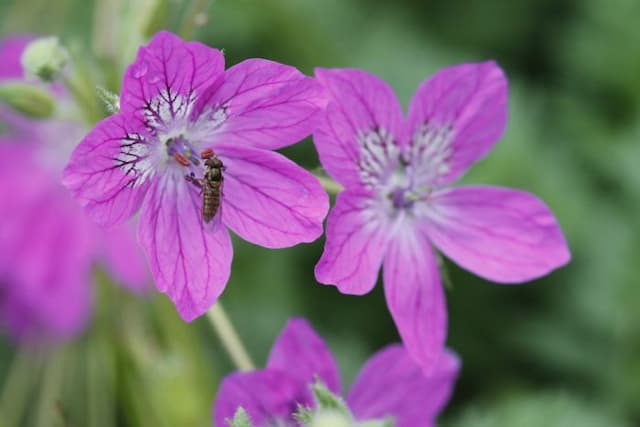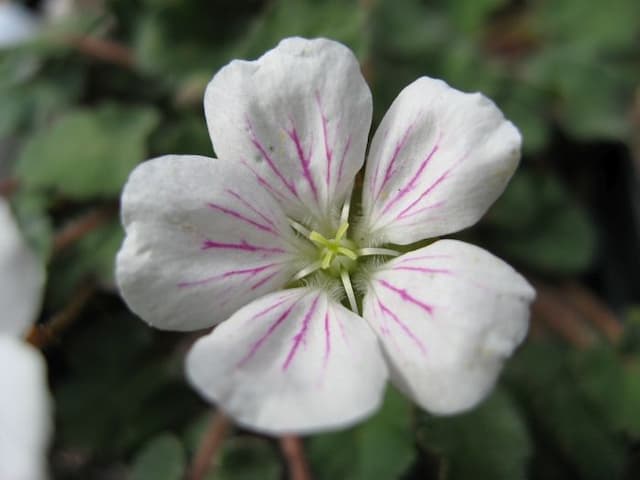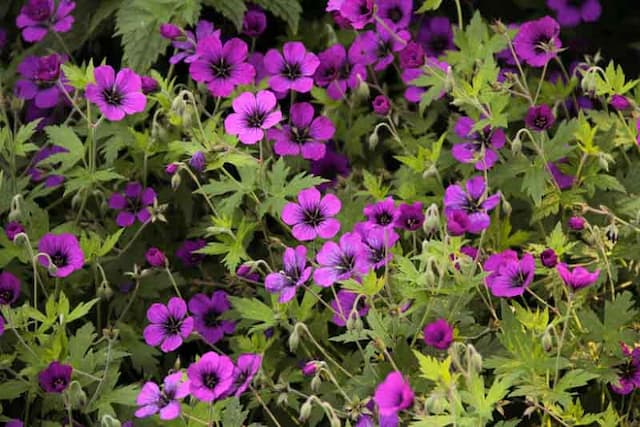Geranium Pelargonium 'Vogue Red' (Z)

ABOUT
The plant known as 'Vogue Red', falls under the commonly referred to geraniums. This vibrant variety is truly captivating with its eye-catching, vivid red blooms that make a stunning display. These flowers have a classical geranium shape but are distinguished by their rich, deep red color which can add a pop of color to any garden or container. Typically, the flowers are clustered together, forming a rounded inflorescence that sits atop sturdy stems, proud and prominent for all to admire. The foliage of 'Vogue Red' contributes to its attractiveness, with leaves that are lush green and sometimes show darker zones or patterns. Each leaf is also quite ornate, with a rounded heart shape that often has a scalloped or serrated edge, providing a textural contrast to the smooth, velvety petals of the flowers. Together, the brilliant red flowers and the green foliage create a classic, yet dynamic combination, that’s appealing to many gardeners and plant enthusiasts. The overall aspect of 'Vogue Red' is one of a robust and bushy plant that can bring life and vibrancy to gardens and homes alike.
About this plant
 Names
NamesFamily
Geraniaceae
Synonyms
Geranium, Zonal Geranium
Common names
Pelargonium 'Vogue Red' (Z).
 Toxicity
ToxicityTo humans
Geraniums, including the 'Vogue Red' variety, are generally not considered toxic to humans. However, they can cause minor skin irritation in some sensitive individuals when they come in contact with the plant's oils or sap. Ingestion is not recommended as it may cause mild gastrointestinal upset, but it is not likely to cause serious harm.
To pets
Geraniums, including the 'Vogue Red' variety, are known to be toxic to pets, especially cats and dogs. The toxic principle is the geraniol and linalool found in the plant. If ingested, it may cause vomiting, anorexia, depression, and dermatitis in some cases. It's important to prevent pets from chewing on the leaves or flowers of geraniums to avoid these potential symptoms.
 Characteristics
CharacteristicsLife cycle
Perennials
Foliage type
Evergreen
Color of leaves
Green
Flower color
Red
Height
1-2 feet (30-60 cm)
Spread
1-2 feet (30-60 cm)
Plant type
Herb
Hardiness zones
9
Native area
South Africa
Benefits
 General Benefits
General Benefits- Aesthetic Appeal: Adds vibrant color and visual interest to gardens and indoor spaces with its striking red flowers.
- Ease of Care: Known for being low maintenance and easy to grow, making it ideal for gardeners of all skill levels.
- Drought Tolerance: Once established, it has a degree of drought resistance, requiring less frequent watering.
- Attracts Pollinators: The flowers can attract beneficial pollinators like butterflies and bees to the garden.
- Seasonal Interest: Often blooms from spring through fall, providing extended periods of color in the landscape.
- Versatility: Suitable for container gardening, hanging baskets, and use as a bedding plant, offering numerous landscaping options.
- Fragrance: The foliage can emit a pleasant scent when touched, adding a sensory aspect to its appeal.
 Medical Properties
Medical PropertiesThis plant is not used for medical purposes.
 Air-purifying Qualities
Air-purifying QualitiesThis plant is not specifically known for air purifying qualities.
 Other Uses
Other Uses- Pelargoniums can be used as a natural dye for fabrics, imparting a range of colors from soft pinks to deep purples depending on the mordant used.
- The scented leaves of some Pelargonium varieties can be infused in sugar to impart fragrance and flavor for culinary uses such as in cakes or desserts.
- Pelargonium leaves can be placed amongst linens or clothes to impart a pleasant fragrance and deter moths and other insects.
- These plants can be utilized in potpourris and sachets to create a natural air freshener for drawers, closets, and rooms.
- The aesthetic appeal of Pelargoniums can be employed in landscape design, providing color and texture to garden beds and borders.
- Certain Pelargonium species are used in the horticultural industry as mother plants for propagation of cuttings.
- The flowers and leaves of Pelargoniums can be used to decorate cakes and culinary dishes as an edible garnish.
- In art, the vibrant colors of Pelargonium flowers can serve as an inspiration for natural pigments and paints.
- Pelargoniums can be grown as companion plants in vegetable gardens to help deter specific pests with their strong scent.
- These plants can be used in educational settings, such as botanical studies and gardening workshops, to teach about plant care and propagation.
Interesting Facts
 Feng Shui
Feng ShuiThe Geranium is not used in traditional Feng Shui practice.
 Zodiac Sign Compitability
Zodiac Sign CompitabilityThe Geranium is not used in astrology practice.
 Plant Symbolism
Plant Symbolism- Comfort – Pelargoniums, commonly known as geraniums, have a calming scent that is often associated with relieving stress and promoting emotional comfort.
- Health – Geraniums are sometimes used in folk medicine, symbolizing a wish for good health and recovery.
- Friendship – The practice of giving geraniums can be a token of friendship and deep admiration, symbolizing a close and stable relationship.
- Positive Energy – With their bright, red flowers, geraniums are often thought to represent positive energy, happiness, and good spirits.
- Fertility – In some cultures, the geranium plant is a symbol of fertility and abundance, due to its lush and generous growth.
- Protection – Historically, geraniums were planted around homes to ward off evil spirits, symbolizing protection and safety.
 Water
WaterGeraniums, including the 'Vogue Red' variety, prefer even moisture. It's best to water thoroughly whenever the topsoil feels dry to the touch, which typically means once a week. However, this may vary depending on climate, humidity, and indoor conditions—less frequent in winter and more during the hot season. Water at the base of the plant to avoid wetting the foliage when using around 16 onzes of water for a standard 6-8 inch pot. Monitor the moisture level in the soil and adjust the watering schedule to maintain consistent soil moisture without waterlogging the roots.
 Light
LightGeraniums like 'Vogue Red' thrive in bright, indirect sunlight. They do best in a spot that receives at least 4-6 hours of sunlight daily, with some protection from intense, direct afternoon sun. An east- or west-facing windowsill is an ideal location, providing the plant with the light it needs without the risk of scorching its leaves.
 Temperature
TemperatureThe 'Vogue Red' Geranium performs well in temperatures ranging from 55 to 70 degrees Fahrenheit. Protect the plant from temperatures dropping below 50 degrees Fahrenheit and from extreme heat as prolonged exposure to temperatures above 80 degrees Fahrenheit can stress the plant. The ideal temperature for vigorous growth is approximately 65 to 70 degrees Fahrenheit.
 Pruning
PruningPruning 'Vogue Red' Geraniums is necessary to promote bushy growth and prevent legginess. Trim back overgrown stems in early spring and pinch off spent flower heads regularly to encourage new blooms. Cuttings can be taken from pruning to start new plants. The best time for major pruning is spring or after the plant has finished its main flowering cycle.
 Cleaning
CleaningAs needed
 Soil
SoilGeraniums, including 'Vogue Red', thrive in a well-draining potting mix with good aeration. A popular soil recipe is to blend equal parts peat moss, perlite, and potting soil; this creates an ideal environment for root growth. The soil pH should be slightly acidic to neutral, ranging from 6.0 to 7.0 for optimal growth.
 Repotting
RepottingGeranium 'Vogue Red' should be repotted every one to two years to refresh the soil and accommodate root growth. It is best to repot in spring before the onset of the growing season.
 Humidity & Misting
Humidity & MistingGeraniums like 'Vogue Red' prefer moderate humidity levels. The best range for these plants is between 40-60%. Avoid overly high humidity to prevent fungal diseases and promote healthy growth.
 Suitable locations
Suitable locationsIndoor
Place in bright, indirect light with some direct sun.
Outdoor
Plant in full sun to partial shade, protect from frost.
Hardiness zone
10-11 USDA
 Life cycle
Life cyclePelargonium 'Vogue Red', commonly known as Geranium 'Vogue Red', begins its life cycle when the seed germinates in warm, moist soil conditions, growing into a seedling with emerging true leaves. As it progresses into the vegetative stage, the plant develops a robust root system and foliage, followed by the formation of distinctive red flowers during the flowering stage, typically in the warmer months. After pollination, which is often facilitated by insects, the plant produces seeds contained within a fruit-like capsule that, when mature, can be dispersed to give rise to new plants. Out of flowering season, or during colder months, the geranium may enter a dormancy stage where growth slows and the plant conserves energy. With proper care, including regular watering and deadheading to encourage further blooming, the geranium 'Vogue Red' can live and continue to produce flowers for several years before eventually reaching the end of its life span.
 Propogation
PropogationPropogation time
Spring-Early Summer
Propogation: The Pelargonium 'Vogue Red', commonly known as a geranium, is best propagated through stem cuttings. This method allows gardeners to clone their desired plants reliably. To propagate, a healthy stem of about 4 to 6 inches (10 to 15 centimeters) long is cut from the parent plant using a sharp, clean pair of pruning shears or knife, making sure the cutting includes several leaf nodes. The cut end is then dipped in rooting hormone to encourage root development and planted in a pot filled with moist potting mix. The cutting should be kept in a warm place with indirect light and the soil should be kept consistently moist until roots have developed, which typically takes a few weeks. Once the cutting has established a robust root system, it can be transplanted into a larger pot or directly into the garden.









![Cranesbill [Rothbury Gem]](/_next/image?url=https%3A%2F%2Fplants-admin.emdemapps.com%2Fimages%2Fplants%2F%2Fimages%2F604b6243984c2.png&w=640&q=75)